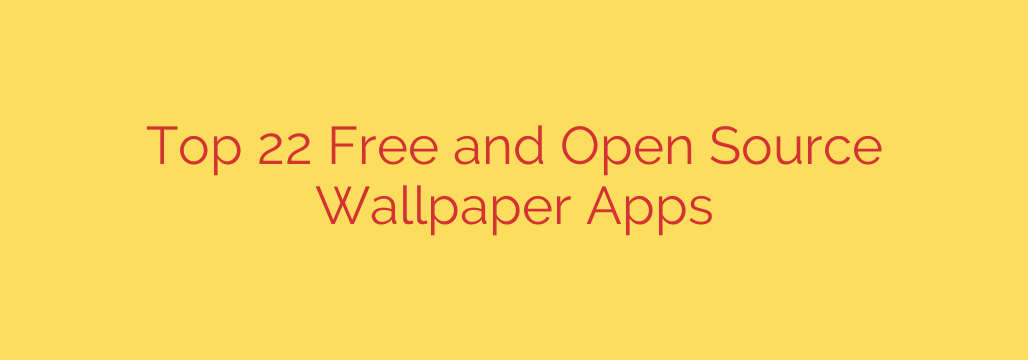
Refresh Your Desktop: The Ultimate Guide to Free and Open-Source Wallpaper Apps
Is your desktop background feeling a little stale? Staring at the same static image day after day can make your digital workspace feel uninspired. Fortunately, a world of powerful, free, and open-source wallpaper applications can automatically transform your desktop into a dynamic and personalized environment.
These tools go far beyond simply changing a picture. They can source stunning high-resolution images from across the web, create dynamic wallpapers that change with the time of day, and even manage complex multi-monitor setups with ease. Because they are open-source, you get incredible functionality without the price tag, ads, or privacy concerns of many commercial alternatives.
Here’s a look at some of the best free and open-source wallpaper managers to breathe new life into your desktop.
For Effortless Variety: Automatic Wallpaper Changers
If you want a “set it and forget it” solution that delivers a fresh look on a regular schedule, these apps are for you.
Variety
A true powerhouse in the wallpaper world, Variety is a feature-packed yet easy-to-use application. It excels at automatically downloading and cycling through wallpapers from numerous online sources, ensuring you always have something new to see.
- Key Features:
- Pulls images from Unsplash, Wallhaven, Flickr, and more.
- Allows you to use your own local folders of images.
- Applies smart and artistic filters to images, like grayscale, blur, and oil painting effects.
- Can display inspirational or humorous quotes on the desktop.
- Highly configurable rotation intervals and source management.
BackSlide
BackSlide is a lean and efficient wallpaper slideshow application designed for Linux desktops using XFCE, MATE, and Cinnamon. It’s lightweight and focuses on one thing: cycling through your favorite images flawlessly.
- Key Features:
- Simple, multi-threaded slideshow functionality.
- Option to recursively scan subdirectories for images.
- Low system resource usage, making it ideal for older hardware.
- Control over the wallpaper change interval.
For Multi-Monitor Power Users
Managing wallpapers across two or more screens can be a challenge, but these tools make it simple and offer advanced control.
Superpaper
Superpaper is an advanced multi-monitor wallpaper manager available for Windows and Linux. It was built specifically to solve the frustrations of stretching a single wallpaper across different displays or wanting unique images on each.
- Key Features:
- Span a single image across multiple screens, even with different resolutions and aspect ratios.
- Set a different wallpaper for each individual display.
- Create wallpaper profiles that you can switch between easily.
- Includes a GUI and a powerful command-line interface for scripting.
HydraPaper
For Linux users, HydraPaper is a fantastic GTK-based application for managing multi-monitor wallpapers. It presents your image collection in a clean, visual interface, allowing you to quickly select and apply wallpapers to each of your connected monitors.
- Key Features:
- Clean and intuitive user interface.
- Easily set different wallpapers for each monitor.
- Automatically detects connected displays and their resolutions.
- Supports adding custom folder paths for your wallpaper collection.
For Dynamic and Live Wallpapers
Take your customization to the next level with wallpapers that move, change, and react to the time of day.
Dynamic Wallpaper Editor
A must-have for users of the GNOME desktop environment, this application allows you to create and edit the dynamic wallpapers that change their appearance throughout the day (like those found in macOS).
- Key Features:
- Create your own time-based wallpapers with a simple graphical editor.
- Drag and drop images to set them for different times (sunrise, day, sunset, night).
- Generates the necessary XML files for GNOME automatically.
- Lets you preview how the wallpaper will change over a 24-hour cycle.
Komorebi
Komorebi offers a stunning way to display animated and interactive wallpapers on your Linux desktop. While it can be more resource-intensive, the visual payoff is significant, allowing for video backgrounds, parallax effects, and more.
- Key Features:
- Supports video, web pages, and custom animations as wallpapers.
- Includes parallax effects that react to mouse movement.
- Highly customizable through easy-to-edit configuration files.
- Comes with a selection of beautiful default wallpapers to get you started.
Choosing Wisely: Security and Performance Tips
While open-source software is generally safe, it’s always smart to follow best practices when installing new applications on your system.
Download from Trusted Sources: Whenever possible, install applications directly from your operating system’s official software repository (e.g., APT, DNF, Pacman, Flathub). If that’s not an option, download from the project’s official website or GitHub releases page.
Check for Active Development: Look at the project’s repository page on GitHub or GitLab. An actively maintained project with recent updates is generally a safer and more stable choice than one that has been abandoned for years.
Monitor System Resources: Live and video wallpapers are impressive but can consume more CPU and RAM. If your system feels sluggish after installing a new wallpaper app, use your system monitor to check its resource usage and adjust its settings accordingly.
By choosing the right tool, you can transform your desktop from a simple utility into a source of daily inspiration and enjoyment.
Source: https://www.linuxlinks.com/best-free-open-source-wallpaper-setters/








